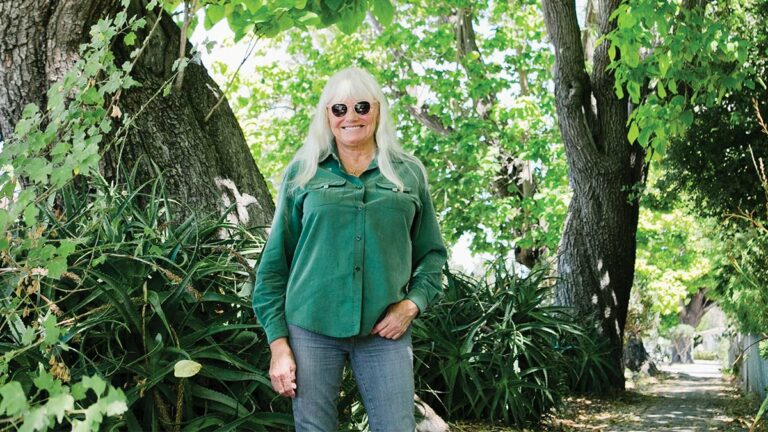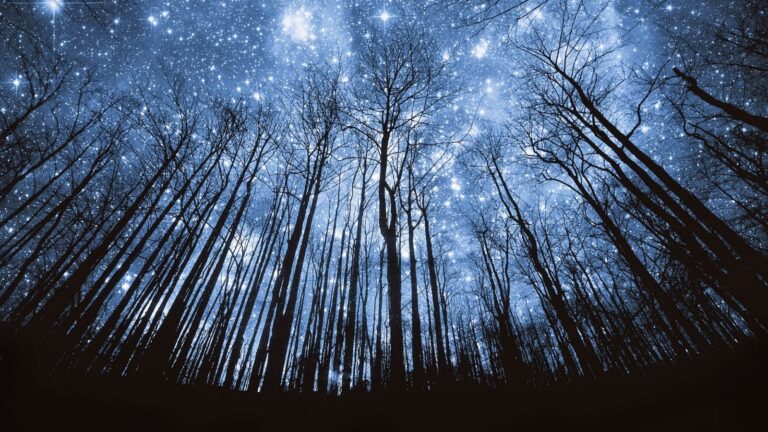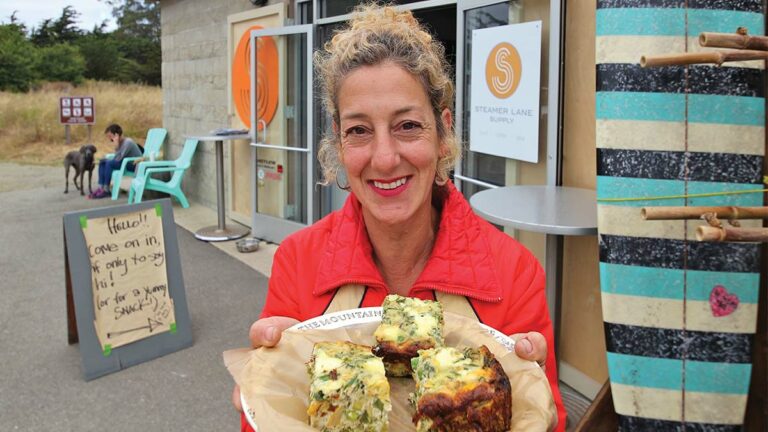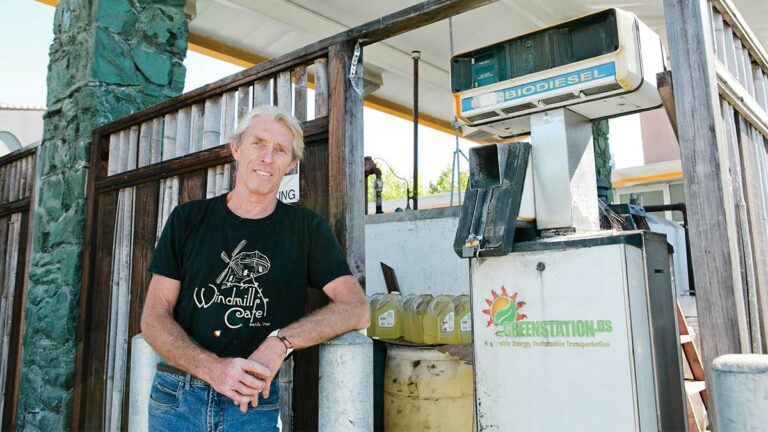In the grand scheme of things, the science of trees is relatively new. There’s still a lot we don’t know, and 1,000-year-old trees that hold the genetic secrets to many unanswered questions are few and far between—and continuing to disappear, even as scientists scramble to clone them. But of the many benefits science has found trees to provide for life on Earth—releasing oxygen, filtering water and air, acting as natural mood elevators, discouraging crime, improving commerce, and hosting microorganisms that may be major contributors to rainfall, just to name a few—the most significant is a voracious appetite for carbon dioxide.
“As natural canopy declines, in the third world and in our country, the urban tree population is really what everyone’s relying on [to mitigate] global warming,” says Leslie Keedy, the urban forester for the City of Santa Cruz since 2000.
We’re standing under the biggest redwood tree in downtown Santa Cruz. Like several other redwoods that have adapted to city life, its massive 6-foot-diameter trunk oozes out over the Church Street sidewalk, which was replaced years ago to accommodate it. “It’s probably about 100 years old,” says Keedy—a baby, compared to a few last old-growth redwoods hidden away in the Santa Cruz Mountains, which are estimated to be 1,400 to 1,800 years old, and top out at nearly 300 feet.

“This is one of our natives. They have flat leaves so they drink the fog, and then the fog drips down. Most of our redwoods don’t have flat leaves, but our coastal redwood does, to kind of grip the fog,” says Keedy. She points toward a second towering redwood behind it, which, under the city’s Heritage Tree Ordinance, is close enough to a law office that its removal would likely be approved if the owner, citing safety issues or structural damage, applied for a permit to do so. “But this one is far enough away that he’ll never get a permit out of me in my lifetime,” Keedy says.
Over the past 16 years, Keedy admits she’s grown a thick skin, much like the bark of the ceiba tree growing at City Hall, as all of the city’s tree removal permits—required for any “heritage tree,” or tree with a 44-inch-or-greater circumference—fall on her. Last year, 296 removal permits were filed with the city, Keedy says, 85-90 percent of which she approved.
“The majority are legitimate requests for property damage, tree health, dead trees and construction,” she says.
The Santa Cruz City Council does, of course, retain the right to overrule a denied permit if the owner appeals, as it did with a century-old redwood tree on Pine Street last year, which was causing damage to a garage. This year’s permit requests include nine heritage eucalyptus trees at a construction site on Western Drive, seven of which will be approved, as three are dead and four warrant removal due to defects and decline in health, says Keedy.
Between 1995 and 2013, 4,000 heritage trees were removed in the city—equivalent in carbon emissions to at least 1,000 cars annually, says climatologist Andrew Gershenson, Ph.D. “Since the fate of most of these trees is to be disposed of by chipping, the vast majority of this carbon is released to the atmosphere within five years,” wrote Gershenson in a letter to city council in 2013.
Of 2,500 permits applied for between 1995-2000, 2,350 were granted. “While the numbers have dropped since then, it’s fair to say we have far fewer heritage trees left to remove,” says Gillian Greensite, a longtime local tree advocate.
This year, though, Santa Cruz’s urban canopy faces a bigger hit than normal, as both the city and county respond to PG&E’s Community Pipeline Safety Initiative, which has earmarked thousands of trees for removal throughout the state within 14 feet of its gas pipelines.
As of a public hearing on July 6, 38 trees on city property, including 10 heritage trees, had been listed for removal, and 275 trees on private property—122 of which are heritage—await review. Separately, in the county at large, 292 public trees and 724 private trees—most of them in the 5th District—are earmarked for removal and awaiting review.
Dwindling Forests
Global forests removed about one-third of fossil fuel emissions from the atmosphere annually between 1990 and 2007, according to the U.S. Forest Service. But global forests are declining at an alarming rate—falling not just to the ax, but also to warmer temperatures, drought and disease.

Currently, Bhutan is the only country in the world with a negative carbon footprint. Here, forests cover 72 percent of the land, absorbing an estimated 6 million tons of carbon dioxide annually, while the country produces only 1.6 million tons. In 2005, the Amazon Basin went from being a carbon sink to a carbon source, following an El Niño drought with high winds that killed, according to NASA, half a billion trees in 48 hours. Substantial forest die-offs in British Columbia became a carbon source in 2008, and the list of significant die-offs continues to grow, as carbon release fuels a positive feedback loop of more warming.
Santa Cruz County, located at the end of a 450-mile-strip that is the only place in the world where redwoods grow, has not been immune to global trends.
“We are at the southernmost end of their range, and, being that, we’re seeing a lot of damage in the landscapes,” says Peter Shaw, Ph.D, chair of the horticulture department at Cabrillo College. “Scotts Valley’s Santa’s Village area, there was a whole row of a cultivar called Santa Cruz, and they are all dead. Probably 30 of them. And I see dead redwoods all over. We’re losing our Monterey cypress, as well.”
Shaw, who has documented more than 283 tree species on his blog Trees of Santa Cruz County, attributes the die-offs to drought and a marked decline in fog over the past few summers. He also notes that the county’s oak trees took a big hit in the sudden oak death epidemic that appeared in 1995, which scientists predict to accelerate after 2020.
The Advocate
I meet Greensite under a tunnel of catalpa trees on Catalpa Street—which is one of the only city streets besides Walnut Avenue where the trees form a canopy over the road. Greensite began advocating for big trees soon after she arrived in Santa Cruz in 1977 and noticed massive 80-to-120-year-old cypress and eucalyptus trees coming down in her lower Westside neighborhood, one after another.
“I didn’t know the system then, so it took me a while,” says Greensite, “but I tried to save quite a few, and was not successful.”
Her list of lost trees is long and meticulously documented, including seven eucalyptus trees that were removed by the Seaside Company from behind the Sea and Sand Inn, ending in 2011. After the trees were removed and their roots rotted, the cliffs collapsed, requiring the Seaside Company to put in a retaining wall, finished earlier this year.
“The myth has developed in Santa Cruz that we’re such a tree city, [that] even if a tree was to fall on your head you’ll never get a permit. It’s really strange how myths arise, because it’s the opposite,” says Greensite. “Santa Cruz does not have a good track record for saving trees.”
Up until the late ’90s, Front Street was lined with 40-60-year-old red flowering gum trees, also known as corymbia, which flame red-orange with flowers in summer.
“It was stunning,” says Greensite. But in the late ’90s, Jim Lang, director of Parks and Recreation at the time, ordered them all removed. “I was sitting next to him when the decision was made, and I said ‘Jim, why would you cut down those beautiful trees?’ And he said, ‘They’re not our idea of a street tree,’” recalls Greensite. “Meaning they drop their stamens and things and were messy.” When asked about the decision for this story, Lang declined to comment.
“People tend to forget that trees are alive, that they’re living things. We tend to just look at them as objects.” — Matt Ritter
There are a couple of red flowering gums remaining down by the Laurel Street bridge, she says, and a beautiful example of a 40-60-year-old red flowering gum on Center and Cedar streets, which Keedy says she saved from being cut down for a Barry Swenson Builder development project, since the roots are primarily on the opposite side of the proposed building lot.
In 2013, the city broadened its Heritage Tree Ordinance, adding allergies and economic hardship to the list of defensible tree removal permits, and exempting itself from conducting environmental reviews. In response, Greensite founded the grassroots organization Save Our Big Trees, which filed a lawsuit against the city for dropping environmental reviews, required by the California Environmental Quality Act (CEQA). Save Our Big Trees lost at the local level, but won at the state appellate level, which ruled that the City of Santa Cruz go back to the previous ordinance.
“That is a stronger ordinance—it obviously doesn’t protect a whole lot, when you look at the numbers of permits, but it’s better than what was going to happen,” says Greensite. “We need, actually, a stronger ordinance, and I hope to be able to work with [Keedy] to craft a truly stronger ordinance that isn’t catering to special interests who would like to remove tree protection, but who truly want to protect trees.”
The Next Fight
The Saturday afternoon sun filters through the catalpa tree’s light-green, heart-shaped leaves, which are interspersed with white flowers in the spring. It’s a mystery who planted these trees, or how old they are, but some of the trunks are massive. Four of the catalpas, which continue on to Melrose Avenue, are slated for removal by PG&E, and, according to Keedy, will not be replaced with catalpas, which she says are a problematic tree due to their tendency to decay. All of the trees removed by PG&E, she says, will be either replaced by three 15-gallon trees, one 24-inch tree, or mitigated with a $150 bond.
“I have no problem with PG&E being concerned about safety,” says Greensite. “However, have all our cities gas pipelines got new valves? Have they got shut-off valves? In other words, has everything been done below ground to ensure safety before we start talking about trees? Now the answer to that could be yes, but I don’t see evidence of that.”

When I ask PG&E spokesperson Jeff Smith for specific examples of trees obstructing pipeline access, he uses the analogy of a car manufacturer sending a car owner a notice about a potential flaw in the car that could pose a safety risk. “And it’s really the same kind of sense behind this,” says Smith, “in that our focus is on safety, and we want to make sure that we have a gas system that is as safe as possible for the community, and we’ve identified this as a potential risk, and there have been instances elsewhere where not being able to have that access has been a concern in terms of making that situation safe.”
Greensite suggests that the city, still working on its final agreement with PG&E, require the utility to map the root systems of each tree slated for removal with Ground Penetrating Radar, to verify its obstruction, but the city has not requested this, according to Keedy.
Private landowners with earmarked trees on their property will soon be receiving notices from PG&E in order to review and negotiate potential removals.
“Our commitment is to not move forward with the replacement of any tree until we have a signed agreement from the customer that they are comfortable with the approach that’s going to be taken,” says Smith.
But Greensite doubts many private landowners will challenge PG&E, since the utility will be appraising the value of each tree and compensating the owners. “I think it’s over 50 percent of houses in Santa Cruz that are non-owner occupied, so the property owner lives somewhere else. And I think the absentee landlords will say, ‘sure, take it down, you’re going to pay me as well? Great’,” says Greensite, who notes that the 110-year-old red horse chestnut tree on Broadway—removed by the city in 2014 to make room for the Hyatt Hotel construction, had been appraised at around $30,000.
When the red horse chestnut tree was finally cut down—following months of community vigils to try to save it—the city made a point of promising to save a neighboring pine tree by putting protective barriers around it, says Greensite. “Well, they started construction, and they sliced down to get all of their concrete laid right next to the tree, and I just noticed yesterday, it’s dead. It’s totally dead,” she says.
Tree City, USA
Santa Cruz is one of 156 communities in California with the designation “Tree City, USA,” given by the Arbor Day Foundation to communities committed to protecting their urban canopies to offset greenhouse gases.
But Greensite says trees are rarely part of the discussion when it comes to the city’s Climate Action Plan. “When I go to their meetings and hear their updates, it’s all about transportation, which is great, and saving energy with lights, etc.” says Greensite. “Trees are so far down on the list.”
In Santa Cruz’s Climate Action Plan, an 80-page document available online, the word “trees” appears three times—counting their mention in the subhead “Green Space, Parks, Gardens and Trees”—on page 71 and 72.

Every year, urban forests alone sequester nearly half a billion dollars’ worth of carbon and remove air pollutants within their communities that would cost nearly $4 billion to clean up in other ways, writes science author Jim Robbins in The Man Who Planted Trees, including very toxic ones, from lung-cancer-causing particulates to benzene, sulfur dioxide, ozone, nitrogen oxides and lead—all of them health hazards.
“If I was going to plant one tree in this country it would be near a building to reduce energy use, to get both carbon sequestration from the tree and reduction in energy use,” says Dave Nowak of the U.S. Forest Service. A tree near a building can reduce the need for air conditioning by 30 percent and reduce 25-50 percent of energy needed for heating, which translates, at the low end, to 16,000-20,000 pounds of carbon in unburned fossil fuel. But the right tree in the right place is so critical that Nowak and his colleagues created a software program called i-Tree, in which homeowners can enter their address to find out energy effects and other services provided by specific trees for their location.
In order to ensure the substantial carbon sink that Santa Cruz heritage trees constitute—1-2 metric tons of carbon absorbed each year for a mature heritage tree—Gershenson recommended, in 2013, that the city significantly alter its replanting policies, and replace trees taken out with trees that are “functionally similar.”
But when I asked the city for its public-record data of trees removed and trees replanted, they were unavailable.
“All trees removed and all trees planted go into the city’s database,” says Keedy, “but the one gal that did it for 20 years just retired [in February], and she was the only one that really knew our new system, and so our data entry has kind of fallen into disrepair, and we are playing catch-up getting all of the trees planted into the database.”
Under the Heritage Tree Ordinance, those who secure a permit to remove a heritage tree must either replant a tree on their property or pay the city $150. The missing data includes the number of bonds paid to the city in lieu of planting.
That said, Keedy estimates that 200-300 trees are planted each year in a non-drought year. But Greensite, skeptical that the number could be so high, says that the majority of people pay the bond rather than replant. “Over the past 30 years, I’ve seen 27 mature, beautiful heritage trees cut down in my immediate neighborhood and one crepe myrtle as a replant onsite for the five large cypresses removed at the end of my street,” says Greensite.
In 2015, being a drought year, Keedy estimates that about 150-175 trees were planted.
“Approximately 80 percent of the trees I see that are in new landscapes right now are crepe myrtles,” says Keedy. “They’re pretty, and they really have their place in the world, but they’re really downsizing the urban forest. They just stay small.”
Matt Ritter, Ph.D., professor of biology at Cal Poly, has been the chair of San Luis Obispo’s Tree Committee for the past seven years. The committee, consisting of seven tree experts that review all of the city’s tree removal permits, grants about 50 percent of 120-200 annual requests. The committee, he says, takes the heat of the decision off of the city, and bolsters the decisions against potential lawsuits.
Ritter says crepe myrtles, often favored by downtown associations and business owners, are an example of inappropriate tree planting. “People tend to forget that trees are alive, that they’re living things. We tend to just look at them as objects,” says Ritter, who equates the crepe myrtle to the closest thing there is to a plastic tree.

“My advice to cities in general is to always plant the biggest possible tree you can that is appropriate for the space. Having a huge boulevard in which you plant these little lollipop crepe myrtle trees is a waste of a tree. They’re capable of making a beautiful accent, but you wouldn’t want them as a boulevard tree because they don’t get very big, they don’t provide the shade, they don’t provide all of the benefits you want from a large canopy cover that can really cool urban places and do everything we want a tree to do for us,” says Ritter, noting that the proven long-term benefits of large canopy trees, like the sycamores growing on the east side of Pacific Avenue, include improved commerce due to people staying longer to shop in shady areas.
As the cherry trees planted along Pacific Avenue—which once hosted a diverse array of tree species, each with their own plaque—die, they will be replaced by crepe myrtles, says Keedy, who also notes that she plants large-stature trees whenever possible, especially in medians where powerlines don’t interfere.
“I’m hoping to plant new canopy trees on Delaware, probably over the next one or two years, but I’m waiting for funding,” says Keedy.
Currently, Santa Cruz’s Heritage Grant Fund, which Keedy says disappeared for a few years during the economic downturn, contains $25,000, down from $50,000 in the early 2000s. The fund is available to assist any resident who wants to care for aging trees. Keedy also notes that anybody who wants to plant a tree on their property for future generations can do so, without a permit—but placement and careful consideration is recommended.
“We shouldn’t think of trees as only beautifying a city or suburb, but as a strategically planted ecotechnology, part of a living, versatile, valuable environmental infrastructure,” writes Robbins in The Man Who Planted Trees. “Planting trees, I myself thought for a long time, was a feel-good thing, a nice but feeble response to our litany of modern-day environmental problems. In the last few years, though, as I have read many dozens of articles and books and interviewed scientists here and abroad, my thinking has changed. Planting trees may be the single most important ecotechnology that we have to put the broken pieces of our planet back together.”
As for the future of Santa Cruz’s heritage trees, Greensite says it depends on a level of consciousness around trees that isn’t there for a lot of people, including those governing the city.
“It’s been very hard to see a lot of the trees go,” she says. “But I tend to sort of not spend a lot of time mourning, and say ‘on to the next one,’ knowing that there will be a next one.”
























